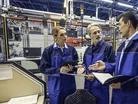Transform operations through precision of execution

While many European organisations have lagged in fully embracing lean manufacturing principles, right now, the pressure to get on board with operational excellence is clear and present. Significant supply disruptions, talent shortages, increased competition, and now high inflation pushing costs out of control have created the “burning platform” companies need to eliminate waste, ensure their organisations run like clockwork, and turn their profitability around both financially as well as on sustainability agenda.
But change takes more than a sense of urgency. It requires capacity, shared vision, and the right action steps to make it happen. Getting these three elements right comes down to Precision of Execution—the behaviours, process discipline, standards, and structure that allow companies to successfully identify areas for improvement and implement changes that lead to sustained cost savings and efficiencies. Companies that master Precision of Execution are fastest and best at achieving breakthrough performance, or sustainable impact of up to 10-30% depending on current state.
André Smaal, TBM Vice President, Europe
Here are five ways to develop Precision of Execution and establish the prerequisites for profitable change:
1. Demonstrate support from the top. However urgent the case for change may be, companies still need a dedicated team of top management, including the COO and other high-level operations leaders, to fully commit to the concepts of operational excellence and lean manufacturing. In organisations where continuous improvement has been traditionally viewed as a short-term initiative as opposed to the long-term mindset it is intended to be, it will take strong leadership to model the shift in thinking and approach. Leaders will need to secure resources and be hands-on in setting priorities, establishing daily and weekly operations discipline, overseeing implementation, and monitoring progress.
2. Actively engage employees. Even the most committed leaders need employee buy-in to achieve the capacity, shared vision, and action for successful change. Employees must be empowered to realise their full capacity and to help identify and eliminate waste in daily operations. Enhanced training and development should be part of your solution. But process discipline is equally important. Start by revisiting daily production meetings to ensure proper focus on KPIs and invite everyone into the conversation. It’s important to recognise that front line employees have unique perspectives into operations challenges, and they genuinely desire positive work environments where operations run smoothly. Unfortunately, it is not uncommon for companies to undervalue or misunderstand their contributions. By structuring meetings to intentionally engage the team, capture valuable knowledge, and demonstrate respect for input, companies can create powerful competitive advantage.
3. Review operations around the clock. Creating capacity for change without investing in more manpower or equipment requires unlocking the untapped potential in existing assets. Most organisations are 60-70% efficient at best. But identifying areas for improvement requires the discipline to review operations performance almost continuously. Organisations that only look at performance once a day or even once or twice a shift have a much more difficult time pinpointing where and why performance is off track. But those that check against KPIs around the clock—for example every five minutes on the shopfloor—gain invaluable insight as well as the opportunity to correct problems as soon as they arise and enable every shift to achieve its goals.
4. Make it visible. Visual production systems go hand-in-hand with continuous audits. This doesn’t have to be anything fancier than a board on the wall where the findings from regular performance checks are recorded for all to see. Start with the basics and show output per production line or station with the right flow on the shopfloor. The visual reminder of the metrics that matter is a powerful motivator. Remember, what gets measured gets done. Engagement and accountability soar when people know exactly what is expected and have a way to easily track and view progress.
5. Encourage immediate action. The Plan-Do-Check-Act cycle is fundamental to Precision of Execution. But it often falls down at the ‘act’ step. When audits and visual boards reveal problems, people at all levels must be empowered to act on the issues and solve them in the moment. This means a line operator doesn’t just step in to get a stopped line back up and running as quickly as possible—the employee goes the extra steps to shares insight into the root causes of issues and takes the required actions that will prevent the problem from happening again.
Remember, it takes more than a burning platform for change
You need the right foundation for freeing capacity, sharing vision, and empowering action. While mastering Precision of Execution takes hard work and a shift in mindset at all levels of the organisation, when people have the discipline, encouragement, and opportunity to contribute to their fullest capacity, breakthrough performance isn’t just possible. It’s inevitable.
André Smaal
TBM Vice President, Europe
André Smaal has more than 20 years of experience as an international consultant, operations excellence strategist, and business transformation expert. He leads TBM Consulting Group’s European operations including business development, client management, and consulting.
- Schneider Electric's Commitment to Sustainable ManufacturingSustainability & ESG
- Lenovo & Saudi Alat Building Green Manufacturing FacilitySustainability & ESG
- BMW: Creating Economic Circularity through Battery CreationSustainability & ESG
- Nissan Brings Biodiversity to the Factory through RewildingSustainability & ESG

